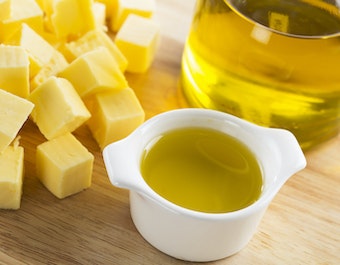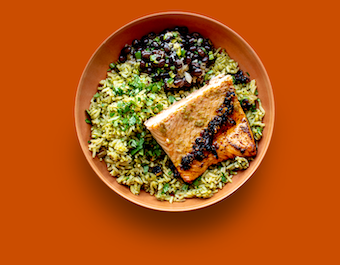Can you be calorie conscious while still feeling satisfied? It’s possible! The trick is to prioritize foods that are relatively low in calories, yet high in fiber and/or protein, says registered dietitian LeeAnn Weintraub, MPH. Because fiber and protein both digest slowly, they can keep you feeling full longer.
Consider these six standout foods that can help keep hunger at bay — plus fresh ways to work them into your diet.
1. Raspberries
High in fiber and low in calories, raspberries are a juicy, hydrating way to satisfy your sweet tooth. When it comes to filling up, raspberries are hard to beat, says Lainey Younkin, MS, RD, LDN, weight loss dietitian at Lainey Younkin Nutrition. “One cup of raspberries has a whopping 8 grams of filling fiber for only 64 calories.” That’s 29% of your recommended daily fiber intake.
On the plate: Raspberries can be a sweet treat on their own, but Younkin also loves treating them as a topper — sprinkled onto Greek yogurt or oatmeal in the morning, or atop a summery salad for a midday fiber boost.
2. Eggs
When researchers asked study participants to eat either an omelet, baked potato, or chicken sandwich for lunch, then rate how full they felt four hours later, those who ate the egg-based lunch had the highest levels of satiety. That makes sense, says Weintraub, because eggs are protein powerhouses that also contain a bit of (mostly healthy) fats. “Fat takes longer to digest, causing the stomach to empty more slowly. This can help with feeling satisfied longer,” she says.
On the plate: If omelets are your thing, have at it! With a two-egg omelet, Weintraub recommends cutting back on the saturated fat just a bit by leaving out one of the egg yolks. You can also load up on low-calorie, high-fiber veggies (like spinach, onions, tomatoes, or peppers) to pack in even more fiber. But there’s nothing that says you have to limit eggs to breakfast. Shakshuka — a North African dish of egg baked in a tomato-red pepper sauce and spiced with cumin and paprika — makes for a scrumptious and filling meal at any time of the day.
3. Oats and Barley
Like most whole grains, oats and barley can help you reach the recommended 22-34 grams of fiber per day. One cup of cooked oatmeal, for instance, delivers 4 grams of fiber and 5 grams of protein, while clocking in at only 150 calories.
But oats and barley also rank particularly high on satiety charts, thanks to the amount of soluble fiber they contain. This type of fiber works wonders in the small intestine, slowing digestion dramatically while signaling to your brain that you’re still full.
In a study in the Journal of the American College of Nutrition, participants who ate a bowl of oatmeal felt more satisfied and reported lower levels of hunger four hours after their meal than those who were given ready-to-eat breakfast cereal.
And a separate study found that when participants ate oatmeal for breakfast they also ate fewer calories at lunch compared with the cereal eaters. The study supports what dietitians have long known: carbohydrates aren’t off-limits. “Too often when you skip whole grains, it backfires later in the day, leading to noshing on less healthful foods,” says Younkin.
On the plate: Fruit is an easy way to flavor breakfast oats, but it’s hardly your only option. Consider going savory, topping oatmeal with sauteed veggies or even adding an egg. Cooked barley is an easy add to bulk up salads or soups, and it also makes a wonderfully toothsome risotto. Barley risotto with feta and lemon is the ultimate — filling! — comfort dish.
4. Leafy greens
Your mom’s dinnertime edict is also good weight loss advice: Eat your vegetables. Especially leafy green ones like kale, spinach, and bok choy. “Leafy greens are high in volume, fiber and water content — and very low in calories,” says Weintraub. “That’s a winning combination for weight loss.” Bonus: Leafy green veggies are also packed with the vitamins and minerals your body needs for optimal health.
On the plate: If crunching crudités feels like a chore, Weintraub suggests sneaking more leafy greens into your favorite dishes: Toss a handful of spinach into your next fruit smoothie, use collard greens as a sandwich wrap or romaine as a taco shell, add finely chopped kale or swiss chard to soups and stews.
5. Fish
In 1995, researchers at the University of Sydney created a satiety index to measure the filling effects of different foods, two hours after participants ate. No surprise that pastries, like croissants, cake and doughnuts, landed at the bottom of the list. Near the tippy top? Fish.
“Protein suppresses hunger hormones, keeping you full longer,” says Younkin, and fish is full of high-quality protein. But fish beating other proteins, like chicken or beef, in the rankings may also have something to do with the omega-3 fatty acid it supplies. A study in the journal Appetite found that when overweight and obese volunteers ate a diet high in omega-3 fats, they reported higher rates of satiety than those who didn’t.
On the plate: Broiled and baked fish will always be a weight loss winner, but there are plenty of more adventurous options to consider. Consider salmon-stuffed avocados, tuna cakes atop a crisp salad, fish tostadas or tacos, or grilled salmon kebabs served with green beans and generous amounts of lemon.
6. Beans
Many people embrace beans as a meat-free main dish, but they pack more than just protein. They’re also high in fiber — and remember, that one-two punch of protein plus fiber is a winning combo when it comes to feeling full while losing weight.
One study, by the University of Copenhagen’s Department of Nutrition, Exercise and Sports, found that people felt more full hours after eating pea- and bean-based meals than when they ate meals of pork or veal. But what’s also wow-worthy is that the bean-eaters tended to eat less at their next meal as well — about 12 percent fewer calories, compared with the meat-eaters.
If you’re looking to add more protein to your diet without adding more red meat (and its accompanying saturated fats), beans — like black or pinto — are a great option, says Weintraub. “They are high in fiber and a good source of protein, which is very satisfying.”
On the plate: Beans are nothing if not flexible. They can take center stage in dishes like black bean burgers, chickpea veggie curry, or hearty chili. But they also work wonders as supporting players, adding satisfying heft (with relatively few calories!) when added to grain bowls, salads, and soups. Weintraub even recommends embracing beans as a snack: A cup of edamame with a little sea salt or low-sodium soy sauce, for instance, is super filling and packs about as much protein as a half pound hamburger.





